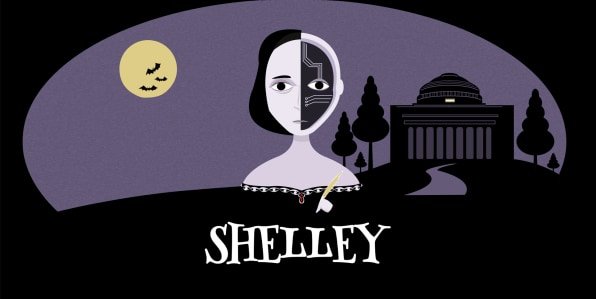Which is scarier: vampires, demon-possessed children, or the idea that artificial intelligence could one day rule the world?
A new project from the MIT Media Lab plays on all three, just in time for Halloween. Called “Shelley” after Frankensteinauthor Mary Shelley, it’s an AI bot that generates the beginnings of horror stories–and then invites human collaborators to keep each bone-chilling tale going. Shelley tweets out a new story every hour; when someone responds and if the story is popular enough, the bot replies with a new sentence that continues the tale. “I would wake up at 4 a.m. and see the girl lying in my bed, her head down, looking down at me. I knew I was being held by her,” begins one story. “My heart is beating so fast it is a bit shorter than my breathing. I think I’m being stalked,” starts another. From these prompts, human collaborators on Twitter imagined a sentient doll’s revenge plot and zombie turkeys. The author of each story is a mishmash of human and algorithm.
While conjuring scary stories is on the silly side of what AI can currently do, the project hints at one successful methodology for AI design–where AI and humans work together.

After receiving 2 million votes from the public on whether the images made by the Nightmare Machine were truly scary, it seemed that they had succeeded in training an AI in horror (the team is still working with the data and plans to publish a paper about it).
But using language to scare us is a trickier challenge than creating scary images–especially because most images generated by neural networks are pretty creepy–or at least uncanny–to begin with. Designing an AI that can write coherently is difficult, given the complexity and variation of human language. Yet Shelley’s stories are intelligible, perhaps because scary stories rely heavily on tropes. To create Shelley, the team trained a neural network on 140,000 horror stories from the r/nosleep subreddit, where people post the most terrifying stories on the internet. The bot also relies on engagement–Shelley measures how many likes and retweets each reply gets and writes more that are stylistically similar. So far, Shelley has written more than 200 stories with her human coauthors. The start of one story spawned seven different threads and 55 tweets.
“We expect Shelley to inspire people to write the weirdest and scariest horror stories ever put together, even invent whole new subgenres of horror that we don’t know they exist yet,” Yanardag tells Co.Design in an email. “Shelley’s creative mind has no boundaries; she writes stories about a pregnant man who woke up in a hospital, a mouth on the floor with a calm smile, an entire haunted town, a faceless man in the mirror, and so on!”
The stories themselves are certainly unsettling, some more so than others. But what makes Shelley so compelling is that it’s not just an algorithm throwing together some words–it’s working actively with people to imagine new things that go bump in the night. It’s part of a vision of artificial intelligence that augments and complements human capacity, rather than replacing it. Shelley is an example of human-in-the-loop AI design–which makes this clever spooky story generator a model for working with AI. Because, after all, Shelley’s stories wouldn’t be nearly so creepy without her human collaborators.
Source: fastcodesign

 I went under the basement door and locked it. I was imagining it and then I felt the claws of something brush against my ankles. 1/2
I went under the basement door and locked it. I was imagining it and then I felt the claws of something brush against my ankles. 1/2
Post a Comment